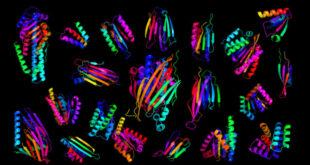After performing an analysis of the antimicrobial properties of a peptide found in the venom of Polybia paulista, a species of South American social wasp, a team of researchers at MIT has engineered several variants of the peptide that are potent against bacteria but nontoxic to human cells. In a study of mice, the team found that their strongest peptide could completely eliminate Pseudomonas aeruginosa, a strain of bacteria that causes respiratory and other infections and is resistant to most antibiotics.
Torres et al developed new antimicrobial peptides based on a naturally occurring peptide produced by the South American wasp Polybia paulista. Image credit: Charles J. Sharp / CC BY-SA 4.0.
As part of their immune defenses, many organisms produce peptides that can kill bacteria.
To help fight the emergence of antibiotic-resistant bacteria, many scientists have been trying to adapt these peptides as potential new drugs.
A peptide isolated from the venom of Polybia paulista is small enough — only 12 amino acids — that MIT researcher Cesar de la Fuente-Nunez and co-authors believed it would be feasible to create some variants of the peptide and test them to see if they might become more potent against microbes and less harmful to humans.
“It’s a small enough peptide that you can try to mutate as many amino acid residues as possible to try to figure out how each building block is contributing to antimicrobial activity and toxicity,” Dr. de la Fuente-Nunez said.
Like many other antimicrobial peptides, this venom-derived peptide, named Polybia-CP (Pol-CP-NH2: Ile-Leu-Gly-Thr-Ile-Leu-Gly-Leu-Leu-Lys-Ser-Leu-NH2), is believed to kill microbes by disrupting bacterial cell membranes. It has an alpha helical structure, which is known to interact strongly with cell membranes.
Schematic of the structure-function-guided exploration approach leveraged to generate peptide antibiotics: (a) the wasp venom derived antimicrobial peptide Polybia-CP was subjected to structure-function analysis to elucidate determinants responsible for biological activity; (b) data from antimicrobial activity, physicochemical properties, and structure analyses was harnessed to (c) identify functional determinants and generate enhanced synthetic variants with therapeutic potential. Image credit: Torres et al, doi: 10.1038/s42003-018-0224-2.
In the first phase of the study, Dr. de la Fuente-Nunez and colleagues created a few dozen variants of the Polybia-CP peptide and then measured how those changes affected the peptides’ helical structure and their hydrophobicity, which also helps to determine how well the peptides interact with membranes.
The researchers then tested these peptides against seven strains of bacteria and two of fungus, making it possible to correlate their structure and physicochemical properties with their antimicrobial potency.
Based on the structure-function relationships they identified, they then designed another few dozen peptides for further testing.
They were able to identify optimal percentages of hydrophobic amino acids and positively charged amino acids, and they also identified a cluster of amino acids where any changes would impair the overall function of the molecule.
To measure the peptides’ toxicity, the team exposed them to human embryonic kidney cells grown in a lab dish.
The scientists selected the most promising compounds to test in mice infected with Pseudomonas aeruginosa, a common source of respiratory and urinary tract infections, and found that several of the peptides could reduce the infection. One of them, given at a high dose, could eliminate it completely.
“After four days, that compound can completely clear the infection, and that was quite surprising and exciting because we don’t typically see that with other experimental antimicrobials or other antibiotics that we’ve tested in the past with this particular mouse model,” Dr. de la Fuente-Nunez said.
The research is published in the journal Communications Biology.
_____
Marcelo D.T. Torres et al. 2018. Structure-function-guided exploration of the antimicrobial peptide polybia-CP identifies activity determinants and generates synthetic therapeutic candidates. Communications Biology 1, article number: 221; doi: 10.1038/s42003-018-0224-2
 #Bizwhiznetwork.com Innovation ΛI |Technology News
#Bizwhiznetwork.com Innovation ΛI |Technology News





